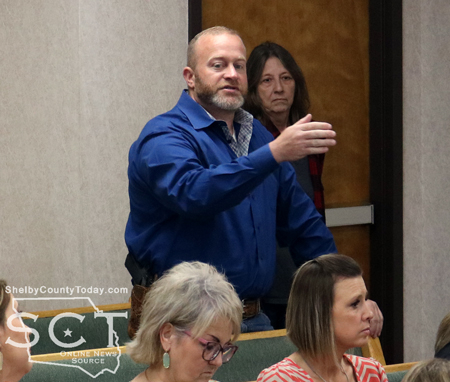
Shelby County Sheriff's Department Chief Chad Hooper thanked the court during their April 17, 2024 meeting.
April 26, 2024 - The Shelby County Commissioners give additional raises through further action on SB22, the Rural Sheriff’s Office Assistance Grant during their meeting held April 17, 2024.
“Going back to the action we took on the Senate Bill 22 in the prior [meeting] to pay the sheriff his additional funds and that was required before we can move forward to use the reminder of the funds in the grant,” said Commissioner Roscoe McSwain.
McSwain stated the county is very positive on its receipt of the grant over the next two years, and proposed utilizing the grant funds to give raises to the chief deputy, investigators, deputies and courthouse security. Should the grant cease in the future, his opinion was that the raises could potentially be absorbed by the county, if that were to happen, and not have any cutbacks.
“We want to move ahead and base this raise from the grant to chief deputy, four investigators, 11 deputies full-time and courthouse security and that's a $5,200 a year raise from the grant,” said McSwain.
McSwain said at that raise, counting the sheriff who will get $8,614 of it, and then with deputies pay that’s $49,414 to give the raise and to meet the county’s requirements.
The breakdown of the increase in salary using SB22 for each is $8,614 to the sheriff; $2,400 to the chief deputy; $2,400 for each of the four investigators ($9,600); $2,400 for each of 11 deputies ($26,400); and $2,400 for one courthouse deputy.
Should the county continue to receive this grant, it would be a welcome injection to help support several needs of the Sheriff’s Department.
“That will leave $292,912.01 of the funds to be used for the Sheriff's Department and radios, vehicles, improvements we need, which is a large sum of money really to be gifted to the county for the next two years,” said McSwain. “That's this year. Next year it will take more of the funds to fund that because the total would be $105,628 of the grant money. So that would only leave $227,967.97 to be used for other things in the Sheriff's Department.”
McSwain remarked over $500,000 through the grant in two years will be used for equipment and vehicles at the Sheriff’s Department, which relieves a large burden off the county budget.
Commissioner McSwain's motion was to move forward with adopting [what was discussed] and apply it to the 2024 budget. McSwain also stated in his motion, with benefits, the total amount of raises is $57,087.99 of the grant, and for the change to go into effect for the current pay period. Commissioner Jimmy Lout seconded the motion, and it carried.
Clint Porterfield, County Auditor, commented, “I will be adjusting the budget. Originally, I had budgeted for a yearly total, but as Mr. McSwain has explained. We're only going to be using it for half of the year. So, what we'll be adjusting for the deputies is for 12 more pay periods, not 26. So that's where the additional money is available of the $292,000.”
County Judge Allison Harbison invited, newly appointed, Chief Deputy Chad Hooper to speak on behalf of the Sheriff’s Department.
“On behalf of the Sheriff's Office, would like to thank the Judge, and Commissioner McSwain, and the auditor for our meeting we had last week, all of the commissioners and everybody involved. I believe it'll be beneficial to staff retainment and hopefully help us quite a bit,” said Chief Hooper.
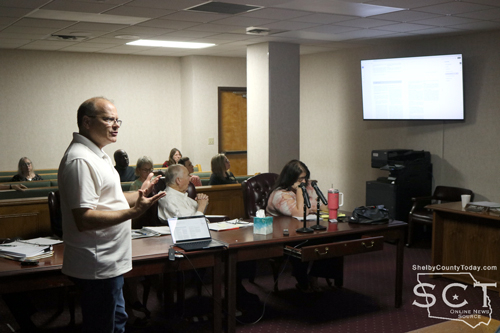
Jay Firsching went over portions of the Historic Courthouse Master Plan with the commissioners.
Jay Firsching from HRTC Services gave the final report on the Master Plan for the Historic Shelby County Courthouse. He was accompanied by Anne Stimmel, an architect with Architexas who sub-consulted on the project with Firsching.
According to Firshing, the report is around 500 pages in two volumes, with half being the study of the courthouse itself and the other half being the appendix which contains every other master plan that has been done on a courthouse in the last 50 years.
“We then have a proposal for what the restoration should look like. Each section has drawings that show various issues, floor plans for what is existing, floor plans for what we're proposing, all diagrammed out. So it's all pretty easy to follow, it's a lot of material, it's too much really for me to go through in great detail.”
Firsching related that the building was partially restored in 1999-2000 using grant funds. The exterior of the building was restored, but only partial work was performed on the interior.
“Part of what we're recommending in this plan is what we need to be done to complete all of that work, but then also to kind of redo what was done back then to bring all the systems up to modern standards,” said Firsching.
Firsching highlighted the geothermal system that is utilized to heat and cool the courthouse as being excellent, when it was put in, but that's no longer the circumstance.
“It's been a real problem in terms of maintenance and when it breaks it does a lot of damage,” said Firsching. “So, we've made recommendations for what we think should be done, which is pretty much abandoning that system in favor of installing a new one that would be easier for you to deal with, costs less to maintain, and things like that.”
Ventilation openings for the courthouse were covered around 1916 when, according to Firsching, a project was undertaken to improve the square and some of the work that was done then wasn't beneficial to the courthouse. The project at that time was meant to make it more like a park around the courthouse, and provide parking for both automobiles and horse-and-buggy.
“In doing that, they brought in many, many, many truckloads of fill, and they raised the level of the square, probably between 16 inches and two feet, and made it very flat,” said Firsching. “The problem that created is they covered up the ventilation openings in the crawl space, to the crawl space in the outside of the building. And by 1999, when they did that work, they made it very flat, all of the floor structure of the first floor was completely rotten and had to be removed and rebuilt.”
A drainage system that was later installed has not resolved the problem, and there is evidence under the historic courthouse of the previous issues occurring again. Firsching explained that if something isn’t done to correct this, then there will likely be catastrophic issues in the future.
Firsching said the electrical system, which was installed in the 90s isn’t a good one, and everything is operated from a breaker box.
“When we talk about a restoration of the courthouse, we don't mean we're making the building like it was in the 1880s we're talking about making it look like a building from the 1880s, but with modern infrastructure where if you went in there today it would feel it would operate like a modern building,” said Firsching.
Along with restoration, plans are being considered to utilize the courthouse for county offices such as for the county commissioners and the county judge. Potentially even having meetings on the second floor. Firsching did say a plan for an exterior fire escape was added to the Master Plan as an option for the second floor due to being a code issue with assemblies being held there.
The budget for the project was put together by Archer Construction out of Paris, Texas, a specialist in historic preservation architecture and construction.
“They put the courthouse work that we're suggesting at about $7 million. That would give you a completely redone building, basically a like new building with all new infrastructure and functionality,” said Firsching.
The Master Plan was done with the idea of complying with Texas Historical Commission's requirements to apply, explained Firsching. A $1 million investment by the county, which has already been invested toward with work performed on the courthouse grounds, would generate $7 million from the Texas Historical Commission.
“The grant for the courthouse that you might get for that would cover the building itself. It doesn't cover site work and things like that. But the money that you spend does count toward your $1 million match, which is 15%. You're 15%, they're 85%,” said Firsching.
A motion was made by Commissioner Smith to approve the final report and Master Plan. Commissioner Bellmyer seconded the motion, and it carried.
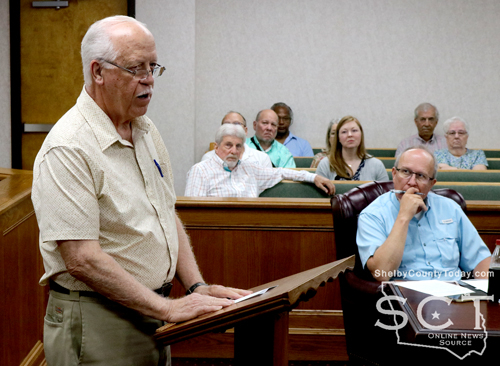
Teddy Hopkins addressed the court about the historic Courthouse on behalf of the Shelby County Historical Commission.
Teddy Hopkins, representing the Shelby County Historical Commission, addressed the commissioners about the courthouse and he was thankful it was built by a professional in J.J.E. Gibson. Hopkins reminisced that when the courthouse was built, the Statue of Liberty was being shipped to New York City aboard a French freightliner.
As docents of the courthouse, the Daughters of the Republic of Texas (DRT) have been regaling visitors with stories of the history of the courthouse as they tour the structure.
“The county has been blessed with the DRT ladies providing tours several days a week for that old building, and I'm sure the community that has had the opportunity to go through that old building will retain memories of what they saw,” said Hopkins.
Hopkins shared that there are families in Shelby County whose ancestors have been here for longer than the courthouse.
“Shelby County goes a long ways and the old building complements that,” said Hopkins.
He stated there is just too much history and historical value to not invest in the historic courthouse.
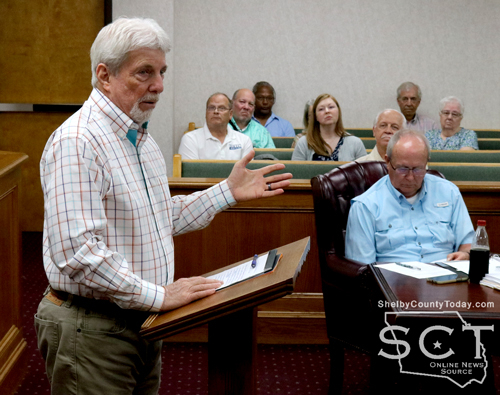
Rayford Copelin, Shelby County historical Commission, spoke with the commissioners about grants to potentially benefit the Historic Courthouse.
Rayford Copelin, representing the Shelby County Historical Commission, also spoke to the commissioners and thanked them for the investment they’ve already made in the courthouse project.
“There's two grants that we'll be applying for, and I don't know which one, the state will decide which one we get. One of them is the restoration grant. That one is an 85% to 15% match from the county. 85% from the state, and it will allow us to do certain things, certain things it won't allow us to do as far as the grant money. Doesn't mean we can't do them, but we can do them and it'll count towards our 15%,” said Copelin.
Landscaping, sidewalks, irrigation are all items the restoration grant will not allow for, but if the county were to invest in the sidewalks it would go toward the county match, according to Copelin.
“One of the things that we're looking at is going back to that 1886 time period when the courthouse was built all the woodwork in there was stained and it was really beautiful,” said Copelin. “When they came in and did the ’99 restoration in some of the ones before that they painted it brown to try to make it look like it was different but it's supposed to be stained.”
Copelin explained the other grant being applied for is the planning grant, which is a 30% match from the county and 70% state match. Copelin says the purpose of that grant is to produce a 95% complete architectural drawing and specifications. Since the county would have to go through an architect anyway, he said this would also benefit that course of action.
There are 22 criteria in the planning grant and Copelin explained that it ranges from the age of the building to the use and to future, amongst other things. Each criteria also carry points with them.
During the meeting Clint Porterfield, County Auditor, shed some light on the county’s financial position in being able to handle the costs of the grant, which is a reimbursable one.
“I think we are all aware of the officers report that's given every month and our investments that we have,” said Porterfield. “Our outside auditors have always recommended we have a 25% reserve in investments, or savings, or whatever you want to call it and we have somewhere over pushing 70%. I will tell you that that we have unencumbered enough money in our investments and savings to meet whatever match we have discussed today.”
He said the county is in a good financial position if the commissioners want to go forward with the application.
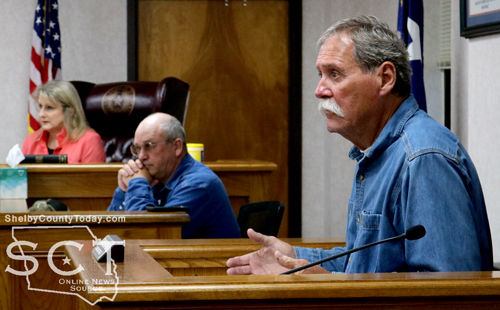
The Commissioners' Court was well-attended and the court had a variety of issues to consider.
Commissioner Bellmyer moved to go forward with the grant application and the county will show it’s support financially if the grant is approved. Commissioner Lout seconded the motion, and it carried.
The commissioners considered bid proposals from two janitorial companies for janitorial services in county offices. B&R Cleaning Services submitted a bid for $5,000 per month, and Denise Shofner bid $3,300 per month.
Commissioner Roscoe McSwain remarked it’s a $25,400 per year difference between the two quotes, and he moved to award the contract to Denise Shofner. His motion was seconded by Commissioner Tom Bellmyer and the motion carried.
Judge Harbison presented the Declaration of Disaster for the flooding of the Sabine River for ratification by the Commissioners’ Court.
“The governor also declared a disaster. He had a statewide one for several counties,” said Judge Harbison. “We're not going to get any reimbursement on this. But this might trigger anyone that needs to get a low-interest loan or anything like that If we do ratify the declaration and anything that can come down from the Small Business Association.”
Judge Harbison said citizens would likely be able to apply for that assistance; however, the county can't be reimbursed, and it would possibly help people that are making claims on flood damage, and for small business loans.
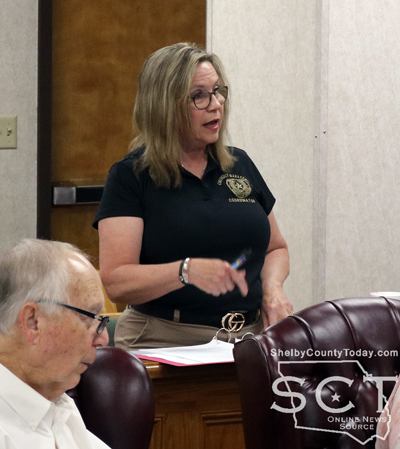
Luciana Barr, Shelby County Emergency Management Coordinator.
Luciana Barr, County Emergency Management Coordinator, stated the threshold for the state which would trigger such reimbursements to the county is over $50 million and we're probably the county of the eight or nine counties that were affected.
Judge Harbison said only six to seven counties issued disaster declarations and with that number she described the only thing that would trigger that kind of assistance is if an entire city had received catastrophic damage.
Barr said four dwellings were destroyed and a lot of damage was incurred as a result of the flooding.
Judge Harbison’s opinion was to leave the declaration in place for two to three more weeks, and Barr commented numbers were still being calculated.
“It's not clear, because we need to get some numbers in on our roads and what damage and estimate on how much it's gonna cost to repair them,” said Barr. “All that needs to be put in there for history. Back in 2016, when this happened, we have roads numbers, but we do not have numbers put in. And you need that type of thing in there so that should we want to get a grant for something like this, you have a history of what roads were affected. I know right now it's like 13, there may be more in Precinct 3.”
Barr indicated Precinct 2 also has some roads probably affected. She issued a “thank you” in court for all of the help that was received during the flood, “Texas Task Task Force One and Two rescue were here. Grand Prairie Fire Department, Killeen Water Squad and Killeen Fire EMS, the National Guard. Of course, our Joaquin Volunteer Fire Department with Chief [Jeremy] Boyett was there and very organized in helping get all of these groups together, our Shelby County Sheriff Department, Shelby County Game Wardens also patrolled the waterway to keep the people off the river because it caused wakes and water to go into homes. The Gainesville Fire Rescue was also there and I'm probably missing somebody, and our commissioners that came out and checked on us and supported.”
According to Barr there were around 50 people that were there every day in support who were very professional, very courteous, and she said they were tremendously appreciated. She indicated Joaquin First Pentecostal Church had been opened as a shelter. Barr said she would like to start looking in to organizing shelters in each jurisdiction for just such situations.
“I want to personally thank Miss Barr. She was there every day. I was there most of the day Friday and she was there representing the county and court, and I really appreciate all your hard work,” said Judge Harbison.
Commissioner Lout publicly thanked Shelbyville and Huxley Volunteer Fire Departments and individuals that helped in Precinct 2.
Commissioner Stevie Smith moved to ratify the disaster declaration, the motion was seconded by Commissioner Lout and the motion carried.
Judge Harbison presented the commissioners with a bill from the Texas Department of Criminal Justice for the building and installation of furnishings to be installed on the second floor of the courthouse in the Community Room for the County Courtroom.
The room has been measured and the total for the furnishings is $10,085, which will be paid out of the Local Assistance Tribal Consistency Fund (LATCF).
Commissioner McSwain moved to approve the $10,085 so it could begin, and the motion was seconded by Commissioner Lout. The motion carried.
The meeting was adjourned at 11:05am.
Agenda items approved during the meeting include:
1. Pay weekly expenses.
2. Award contract to Denise Shofner for Janitorial Services at $3,300 per month.
3. Use SB22 Rural Sheriff’s Office Assistance Grant to provide raises at the Sheriff's Department.
4. Ratify the Declaration of Disaster for the flooding of the Sabine River.
5. Furniture to be constructed by the Texas Department of Criminal Justice for the Commissioners’ Courtroom on the 2nd Floor of the County Courthouse in the amount of $10,085.
6. Final report on the Master Plan for the Historic Courthouse.
7. Application for the Texas Historical Commission Courthouse Grant.
8. Adjourn 11:05am









